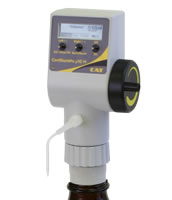What to Look For in an Entry Level Bottletop Burette
Digital bottletop burettes are precision dispensing tools in many research organizations. A reason for their popularity is ease of use and high precision when compared to volumetric glass tube burettes and pipettes. They are also easier to clean and maintain, and are not nearly as subject to breakage.
Labs contemplating the purchase of a digital buret may be reluctant to proceed due to the costs of these systems in comparison to glass tubes. On the other hand, there are definite long-term economies with precision bottletop dispensers. This means that over time the investment will be repaid in several ways including:
- Absence of glass tube breakage and resulting cost of replacement
- Saving the cost of cleaning glass tube burettes and pipettes
- Faster, more precise dispensing without relying on eye-hand coordination
- No meniscus reading errors
- Low/no reagent loss that can occur when manually filling volumetric burettes
Start with a Manually Operated Bottletop Burette
Burette pricing is based a lot on operating capabilities of these lab instruments. High end models are equipped with a motorized pumping system powered by a 9-volt adapter, provide a computer interface for record keeping and may also have a self-contained cleaning system. The important thing to remember is that pricing does not determine the accuracy of CAT Contiburette® bottle-top burettes. The standard that applies to all models is Class A of ASTM E287-02 2007 “Standard Specification for Laboratory Glass Graduated Burets.”
The manually operated model can be specified with dispensing rates in either 10 or 20 µl (micro liter) subdivisions. These are the smallest amounts of reagents dispensed at one pump stroke. The maximum flow rate of these models is, respectively, approximately 12 milliliters and 20 milliliters per minute. The total amount of reagent that can be dispensed is limited only by the bottle capacity.
Operation is by a hand crank attached to the dispensing mechanism. Two AA batteries are used for programming the dispensing rate and volume, to power flow rate and volume indicators and the liquid crystal display.
Another feature of these entry-level Contiburettes is their valveless construction. Valves in dispensing mechanisms can introduce what is called “dead volume” that impacts the accuracy of bottletop burettes. Instead, precision pumping configurations assure continuous accuracy during metering and dispensing operations.
Finally, we mentioned above the ease with which these burettes can be cleaned. This is accomplished by unscrewing the assembly from the bottle, carefully shaking out reagent from the tubes and inserting the assembly into another bottle filled with a properly formulated cleaning solution.
Operate the Contiburette to pump cleaning solution through its mechanism. Normally a good cleaning results when you pump a minimum volume of 50 times the unit’s stroke volume. The procedure along with other operating information is provided in the user manual.
Pricing for CAT manually operated bottletop burets is less than $700.00. With proper care these versatile measuring and dispensing devices should provide years of trouble-free service in addition to delivering outstanding accuracy. If you’d like more information on CAT Scientific liquid handing systems simply ask us a question. We’ll be back pronto with an answer.


[…] you select a hand-operated or motor-driven bottletop burette depends on the nature of your work. For example, automated continuous dispensing favors a […]
[…] you select a hand-operated or motor-driven bottletop burette depends on the nature of your work. For example, automated continuous dispensing favors a […]